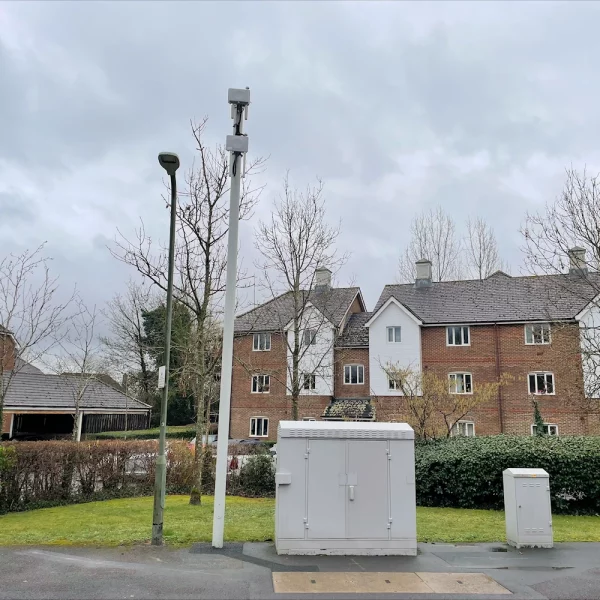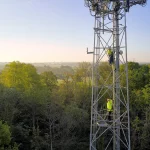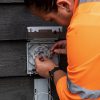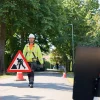Virgin Media O2 UK Trial Mobile Small Cells Next to Broadband Cabinets

Broadband and mobile operator Virgin Media (O2) have today hailed the results of a new trial – delivered in collaboration with shareholder Liberty Global, which is said to have “successfully” deployed 4G and 5G “smart poles” on top of its existing fibre broadband cabinets in the UK to help boost mobile network coverage and capacity.
The idea here is simple enough. Virgin Media has around 25,000 street cabinets deployed across the UK to serve their fixed line broadband ISP network and at the same time they’ve also been developing a lot of small cell related deployments to help improve mobile coverage – the two approaches are complementary, with the trial showing Virgin’s cabinets can support a supply of both data capacity and power for the cells.
The trial has thus seen “innovative new smart poles” installed beside VMO2’s existing on-street broadband cabinets. The new poles house 4G small cells and are much smaller than traditional phone masts, meaning they don’t require planning permission and can be installed in less than a day (albeit not always terribly popular with locals in every street).
Advertisement
“In a UK first, the electricity is supplied by Virgin Media’s fibre network rather than a traditional power supply through innovative ‘digital electricity’ technology, which transmits power from on-street cabinets in the local area along fibre optic cables. The same fixed fibre network is also used to carry data to and from the mobile cells and the internet,” said VMO2’s announcement (just to be clear, the power and fibre supplies are separate parts of a new hybrid cable).
By comparison, the normal approach to deploying mobile infrastructure can be time-consuming as it typically involves obtaining planning permission for new or upgraded infrastructure, installing radio equipment, connecting sites to the power network, before establishing fibre connections to carry mobile traffic to the internet (backhaul). For many non-converged mobile operators, this involves paying for a fixed backhaul connection, which is often provided by a competitor.
Jeanie York, CTO of VMO2, said:
“As we continue investing to upgrade and expand our network, we’re always looking for new ways to work smarter and deliver more for our customers. Groundbreaking trials like this can help boost mobile coverage and bring next generation services to even more customers.
The ability to use our existing national fixed network to backhaul and power small cells could be transformational – helping us save time and money, open up new revenue streams, support smart city technology and fully leverage the benefits of our scaled converged network.”
The operator notes that “smart city infrastructure“, such as electric vehicle (EV) chargers, can also be built into the poles, providing new opportunities for Virgin Media O2 to further monetise its network in future. This is particularly relevant since Virgin Media’s existing infrastructure has already been used to help support EV charging via Believ‘s network.
However, not every one of their cabinets will be viable for this sort of the deployment, and the operator has yet to clarify what their wider roll-out plan might be.
Advertisement
Mark is a professional technology writer, IT consultant and computer engineer from Dorset (England), he also founded ISPreview in 1999 and enjoys analysing the latest telecoms and broadband developments. Find me on X (Twitter), Mastodon, Facebook, BlueSky, Threads.net and Linkedin.
« Ofcom UK Warns its Powers are Limited on Broadband Poles






















































Good initiative!
Hope they also include 5G/N78 in the deployment.
The public don’t want this crap.
Only people wanting this tech is fat gamers.
Won’t work and a complete waste of money.
While offensive, it’s accurate. So many people just want tiktok to load. They don’t care if it comes over wet string or sensible fibre.
Adam Hartson says:
The public don’t want this crap.
Only people wanting this tech is fat gamers.
Won’t work and a complete waste of money.
Err you don’t speak for me.
I am gamer all my games are digitally owned so fast 4G and fast 5G is ideal.
Virgin media are a complete rip off open leech are just as bad.
It’s nimbys like you Adam is holding the uk back to the 19th century.
I want it. I’m a member of the public.
Why would fat gamers want small cells? The latency on mobile networks would not be good enough for them if your sterotypical nonsense is to be believed.
Unfortunately adam, if you read the article, it clearly states that this does in fact work.
Adam Hartson, please could you kindly return back into your hole, from which ever decade you crawled out of. You are precisely the problem this country is facing with the collective nimbys and idiots holding back progress.
Surely fat gamers want fibre for the low latency, not 5G towers and their horrible variable latency?
And here we are: https://www.ispreview.co.uk/index.php/2024/03/gws-study-claims-uk-mobile-users-satisfied-with-1-5mbps-speeds.html
I see 5G being helpful to the mobile provider for user density in a city center or event venue.. but for speeds so many people just don’t care about the headline speeds.
The vast, vast majority of people just want basic connectivity and a screen just good enough to read the news. It is the operators who make money out of selling big-screen, data-hungry handsets. Not to mention getting you on multi-year contracts, where you pay hundreds and hundreds of pounds for a handset which has far more capability than you will ever need. Why do we think the Operators buried Nokia’s 3310?
So they admit the public don’t want them but installing anyway.
Technology only succeed when the public want it.
How many Telcoms will fail in the coming years.
The public don’t want visible infrastructure, but they complain like buggery when they can’t get a decent mobile signal. They want it to work, and they want it to be invisible.
This is such a good idea. If they added these at the same time as they did the XGS upgrades they’d end up with a massive network of small cells by 2028. Just what you need for over 35 million customers.
If EE and Openreach followed this idea they’d cover a network black spot on our street.
BT & EE are already trialing this for last few years,at Adastral park in Suffolk
@Tyler
What is being developed at Adastral Park does not mean it will evolve to deployment to BT or EE any time soon. I was there some time ago when they had developed and proved symetrical !Gb U/D speeds, they have not appeared yet on the Openreach network except for businness.
Adastral Park does a huge amount of reseach and development, not all comes to Openreach and vast amounts (in comaparison) goes to other companies.
I also remember seeing 4K TV 3 years before you could buy one in ths country.
Can’t see much to complain about here. It’s no more obtrusive than a street light (no doubt some will though). Wonder if EE will do the same with Openreach wooden poles.
A smart way would be to combine a street lamp with an aerial – there is a street lamp a metre away in the picture. Surely no one can object to that.
I used to work for a street lighting installation, maintenance and operations company, and it’s entirely feasible to use a lighting column for small 5G aerials. For larger aerials less so because they impose higher than design loads, especially in high winds, but the sort of thing shown in the photo is easily possible. The problems are various, and include that much highways lighting has been put out to PFI contracts, and getting the highways authority to agree and the PFI operator is very difficult and often costly – no matter how small the risks, nobody wants to take them on. And there’s complications like the council/PFI may not want the street lighting power to power the 5G unit (meaning expensive sub-metering or a second live power circuit in the column), that the column has to be pretty much adjacent to the data connection because trenching in pavement is very expensive so for more than say 5 metres of trenching it may be cheaper and easier to put up the sort of small mast in the photo. Using street lighting columns is an sound idea and does work – but only if you’ve got a very cooperative owner/operator of street lighting (no always the case) and you’ve got an available lighting column close to the data feed, and that column needs to be in good condition – makes no sense adding 5G onto a knackered 40 year old column that’ll be replaced in a year or two. If dealing with the various different councils and PFI companies is too onerous, then network operators will do exactly what VMO2 have done in the picture – cheap, quick, practical.
The outfit I worked for reasoned that 5G was a marvellous growth opportunity about ten years ago, since we had the PFI assets and the skills to do all of it except the final data connection, in the end it simply never took off. Streetlighting “decision makers” are like infrastructure managers everywhere – they are deeply conservative and risk averse, and whilst in this instance you might not approve, it is actually a very sensible approach when managing long lived assets that people expect to work, and to work at very low cost.
This could be game changing if they deploy 5G SA (with all the correct bands) to these, a gigabit+ capable connection with it’s own fibre backhaul providing a strong signal to the local area would relieve a lot of the pressure off the macro sites and give far greater reliability in the places people need it- inside the home
As a non-binary gamer married to a trans gamer, 4G / 5G has never been on our list of ways to connect when it comes to gaming. However, being able to access, say our music whilst on the move or, reliably be able to get into our Tesco app so we can check for offers, now, that is a great use case for having lots of small cell sites. As for the “intrusive mast” I had to look at the pic twice to see it wasn’t just a telegraph pole.
“As a non-binary gamer married to a trans gamer”
Which has what relevance to the topic?
As a bisexual cyclist and motorist who is a council tax payer, employee, parent and person who uses a shower daily we have to be concerned or excited as appropriate to this story.
Government: less towers!
Virgin Media: MORE TOWERS!
VM/O2 mini towers instead.
Totally agree, whole industry has become deaf.
5G has made reception far worse where I live.
I don’t want a large pole or a small pole anywhere near my home.
Should have left 3G/4G alone.
Just to clarify a small point:
The article states: (just to be clear, the power will come from a separate cable alongside the fibre, which cannot itself carry electricity).
Clarification: This trial was deployed with a Hybrid cable, hence one cable which has Fibre & Copper in one jacket and it was also blown down tubes for a very quick deployment. this took 1,5hrs from start to finish.
I made my comment because the original press release made it sound like the electricity supply was coming over the fibre itself, which is of course impossible :). But I like your description better.
Wouldn’t power be available from the PSTN network that Virgin/O2 already has in many cabinets?
I don’t see the point of trialling a hybrid cable when VM is going flat-out to build an all-fibre network. And if broadband, audio, video and voice can be transmitted over fibre then why not electricity. After all Power over Fiber (PoF) already exists, using lasers to convert electrical power into optical power, which is then transmitted over fibre and converted back into electrical power at the receiving end.
actually not impossible 😉
high powered lasers are being used for electricity transmission already. although they tend to be free space optics they work down fibre too. It’s literally called “power over fibre”.
The lasers being used to transmit data are usually in the milliWatt power range if that gives a hint, Roger.
Photovoltaic technology isn’t really there yet when it comes to power over fibre. I don’t think it’s actually implemented because the most electricity you’ll get out of it at the other end on a good day is about 1 W. An implementation in fibre would use a separate laser to transfer power, though I’ve seen free-space demonstrations using solar panels and low data rates, where power is derived from the data signal.
Excellent initiative by VMo2 and shows what can be done when they have techies rather than accountants running the show..
We do need alternative solutions as there is not a one size fits all solution…
Wether we want it or not is irrelevant. This will be good for capacity in addition to speed. It can be especially important if a main mast goes offline, as these small cells could still deliver an important limited level of coverage.
Three have small cells in few areas and Vodafone in rural villages. They should be more widely deployed. Even if it’s just LTE-A [4G-Advanced]
This is a great idea. And it’s also sure to make the boomers seethe (more evil 5G poles).
Top stuff
“which transmits power from on-street cabinets in the local area along fibre optic cables”
“electric vehicle (EV) chargers, can also be built into the poles”
Checks date… are you sure this wasn’t on embargo for another two week?
Where is the public consultation regarding these trials?
They don’t need to – “The new poles house 4G small cells and are much smaller than traditional phone masts, meaning they don’t require planning permission and can be installed in less than a day (albeit not always terribly popular with locals in every street).”
Therefore no consultation is really needed.
Isnt this an unfair advantage against other mobile networks?
That pole looks slightly off to me, its leaning to the right.
I like the idea of this initiative in principle, however I can think of 2 key issues:
1) as a Virgin Media (fiber) & O2 (mobile) customer, I’m used to having to tether from my phone at least once or twice a month to enable me to work from home during Virgin Media outages. If both the Virgin and O2 networks suffer an outage at the same time due to shared shared street infrastructure, I presume I’d not be able to use O2 as my backup internet connection to enable me to work.
2) as already mentioned, adding more visible street furniture is unfortunate and divisive across the community.
Apologies, in the last sentence “diverse” should read “divisive”.